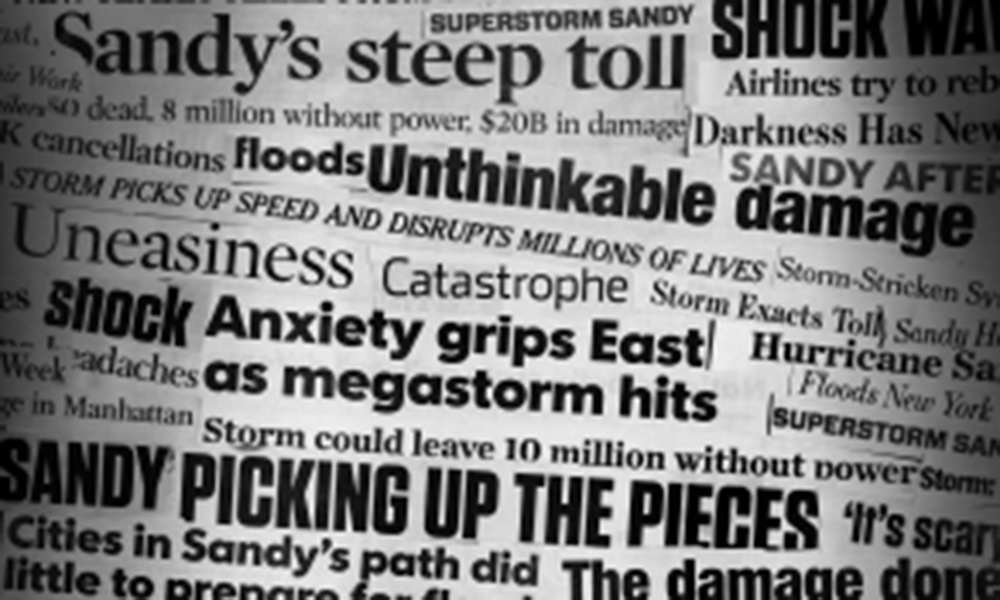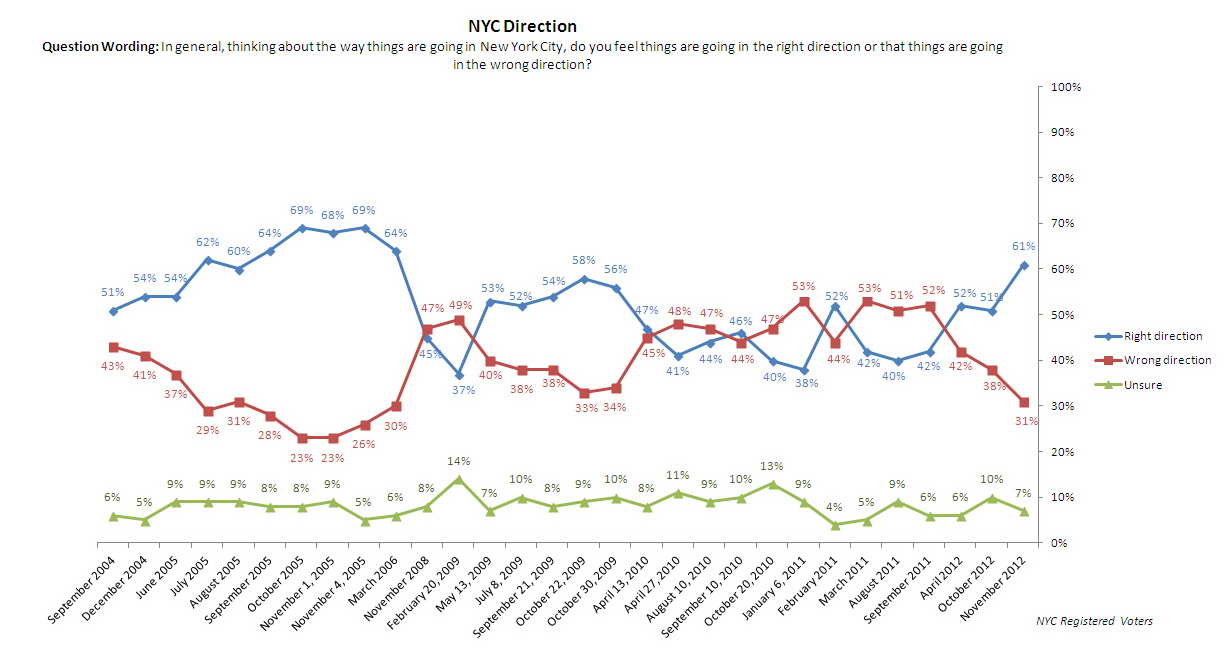December 3, 2012
12/3: NYC Not Prepared for Sandy
NY1/Marist New York City Poll
Five weeks after Hurricane Sandy pummeled the East Coast, nearly six in ten New York City residents — 58% — think the city was not properly prepared to battle the monster storm. 38% believe New York City’s preparation to respond to the storm was adequate, and 4% are unsure.
Click Here for Complete December 3, 2012 NYC NY1-Marist Poll Release and Tables
“For the most part New Yorkers say the city was not ready to handle the superstorm,” says Dr. Lee M. Miringoff, Director of The Marist College Institute for Public Opinion. “Despite this view, most are positive about the official response.”
Not surprisingly, residents who were most affected by the storm are more likely to say New York City was ill-prepared to deal with such a cataclysmic event. 77% of these residents have this view. This compares with 60% who were directly affected, and 56% who were not directly affected by it.
By borough:
- In Staten Island, 61% of residents think the city’s preparation missed the mark while 36% say it was on target. Two percent are unsure.
- In Queens, 60% have a negative view of how the city prepared while 38% have a positive one. Two percent are unsure.
- 58% of Brooklyn residents believe the city was not prepared to deal with Sandy while 36% think it was. Six percent are unsure.
- Among residents in Manhattan, 58% say the city’s preparation fell short while 41% thought it was a result of proper planning. Two percent are unsure.
- In the Bronx, 55% of residents report New York City was not ready to deal with the storm. 41% believe it was, and 4% are unsure.
What do residents think of how public officials and agencies handled the storm?
- Seven in ten residents in New York City — 70% — approve of how Mayor Michael Bloomberg dealt with Sandy while 25% disapprove. Five percent are unsure. Among those who were most affected, 53% approve of Bloomberg’s actions.
- New York Governor Andrew Cuomo fares even better. Among New York City residents, 82% believe Cuomo took the right steps to handle the hurricane. 10% disapprove of his approach, and 8% are unsure. Even 78% of those most affected by the storm give the governor high marks.
- 81% of New York City residents praise New Jersey Governor Chris Christie for how he dealt with Hurricane Sandy. Seven percent disapprove, and 13% are unsure. Among those who were most affected by Sandy, 72% think well of how Christie dealt with the storm.
- President Barack Obama — 85% –fares the best in the eyes of New York City residents. 13%, though, disapprove of his actions. Two percent are unsure. More than three in four New York City residents most affected — 76% — applaud the president’s response to Hurricane Sandy.
- About two-thirds of city dwellers — 65% — think well of how Con Edison managed the situation. 28% thought the power company fell short, and 7% are unsure. Among those who were most affected, 55% are positive about Con Ed’s performance.
- It’s a far different story for LIPA. Only 20% of New York City residents say the utility company’s response was on target. A majority — 54% — disapproves, and 26% are unsure. Just 19% of those who were most affected by the storm think LIPA did a good job dealing with it.
- 76% of residents in the city give the MTA a thumbs-up. 18% disapprove of how it dealt with the storm, and 6% are unsure. A similar 73% of adults most affected by the storm think well of the MTA’s actions to handle Hurricane Sandy.
- Almost seven in ten in the city — 69% — think well of how the New York City Department of Education managed the situation. 20% disapprove, and 11% are unsure. Even 65% of those most affected approve of how the agency dealt with the situation.
- Looking at the New York City Housing Authority, there is a divide. 39% of residents approve of how the agency handled Sandy while 35% disapprove. A notable 25% are unsure. Only 36% of those who were most affected by the storm approve of how the NYCHA handled Hurricane Sandy.
- Nearly two-thirds of city dwellers — 64% — have a favorable view of FEMA’s response to the storm. 24% believe the agency missed the mark, and 13% are unsure. Among those most affected, 59% approve of how FEMA dealt with the storm.
Table: New York’s Preparedness to Deal with Hurricane Sandy
Table: Mayor Michael Bloomberg’s Handling of Hurricane Sandy
Table: New York Governor Andrew Cuomo’s Handling of Hurricane Sandy
Table: New Jersey Governor Chris Christie’s Handling of Hurricane Sandy
Table: President Barack Obama’s Handling of Hurricane Sandy
Table: Con Edison’s Handling of Hurricane Sandy
Table: LIPA’s Handling of Hurricane Sandy
Table: MTA’s Handling of Hurricane Sandy
Table: New York City Department of Education’s Handling of Hurricane Sandy
Table: New York City Housing Authority’s Handling of Hurricane Sandy
Table: FEMA’s Handling of Hurricane Sandy
Most Think Sandy United the Big Apple, But…
87% of residents in New York City believe Hurricane Sandy mostly united people in New York City. Eight percent say it mostly divided them, and 4% are unsure.
However, when it comes to the allocation of aid post-Sandy, there is a split. 46% of adults citywide believe some neighborhoods affected by the storm were treated better by the city than others. 44%, however, think help was provided fairly. 10% are unsure.
Those who were most affected by the hurricane — 64% — are more likely to report an unbalanced distribution of assistance following the storm compared with those who were directly affected by Sandy — 49% — and those who were not directly affected by the storm — 43%.
By borough:
- A slim majority of residents in Manhattan — 51% — believe some neighborhoods were treated better than others. This compares with 38% who say help was provided fairly.
- In the Bronx, 49% of residents believe resources were not distributed well while 44% think they were not.
- 48% of adults in Brooklyn say some neighborhoods affected by the storm were treated better than others. 40%, though, think help was provided fairly.
- In Queens, more than four in ten residents — 41% — report assistance was not fairly distributed while 48% believe it was.
- Among those in Staten Island, 38% say the city treated some neighborhoods better than others, but 54% believe aid was given out fairly.
Table: Whether Hurricane Sandy Mostly United or Divided New York City
Table: Allocation of Assistance Following Hurricane Sandy
Nearly One in Five Say City Will Never be the Same
While most residents believe New York City has either returned to normal or will eventually do so, a notable proportion believes the Big Apple will never be what it was before Hurricane Sandy. 16% say the city has already recovered while 65% think it will eventually return to what it was. 19%, however, think it will never be the same.
Residents who were the most affected by Sandy are the most pessimistic. 30% of these residents think the city is forever changed in the wake of the storm. Still, 64% of these residents believe the city will eventually return to normal.
Table: Whether or Not New York City will Return to Normal Following Hurricane Sandy
Optimism in NYC Reaches Highest Level in Six Years
While Hurricane Sandy may have left a path of destruction behind, that has not broken the spirits of more than six in ten registered voters in New York City. 61% believe New York City is moving in the right direction while 31% say it is traveling in the wrong one. Seven percent are unsure. The proportion of voters who think the city is moving in the right direction is the largest since March of 2006. At that time, 64% of voters said the Big Apple was on track.
When NY1-Marist last reported this question in its October survey, 51% of registered voters citywide thought the Big Apple was on the right path while 38% said it was on the wrong one. 10%, then, were unsure.
Regardless of party or borough, more voters believe the city is moving in the right direction.
Table: New York City Direction
Table: New York City Direction Over Time
Bloomberg Approval Rating Highest Since 2010
50% of registered voters in New York City believe Mayor Bloomberg is doing either an excellent or good job in office. This includes 15% who think he is doing an excellent one and 35% who say he is doing a good one. 33% rate Bloomberg’s performance as fair while 16% say it is poor. One percent is unsure. This is the highest job approval rating Bloomberg has received since October of 2010. At that time, the same proportion — 50% — gave the mayor high marks.
In NY1-Marist’s October 2012 survey, 45% of registered voters had a favorable view of Bloomberg’s performance as mayor. 32% thought the job he was doing was average while 20% said it was subpar. Three percent, at that time, were unsure.
By borough:
- The mayor does best among Manhattan voters. Here, 67% applaud Bloomberg’s performance, up 22 percentage points from October.
- 46% of Brooklyn voters also think well of how Bloomberg is doing his job. In October, 38% held this view.
- Among Bronx voters, 43% approve of how Mayor Bloomberg is doing his job, compared with 50% two months ago.
- In Queens, 46% of registered voters give the mayor’s performance a thumbs-up.
- Looking at Staten Island, 41% give Bloomberg’s performance high marks.
Table: Mayor Michael Bloomberg Approval Rating
Table: Mayor Michael Bloomberg Approval Rating Over Time
Bloomberg and Giuliani Vie for Title of NYC Mayor Who Would Best Handle Hurricane…Bloomberg Legacy Intact
Although Mayor Bloomberg tops the list of mayors who could best handle a weather crisis, Rudy Giuliani follows close behind in the opinion of New Yorkers. 39% of adults in the city have this view of Bloomberg, 37% believe Rudy Giuliani would have best tackled the situation. Ed Koch is thought by 9% to have best dealt with the storm compared with just 4% who have this impression of David Dinkins. 10% are unsure.
When it comes to Bloomberg’s overall legacy, a plurality of voters — 43% — expect him to be remembered positively after he leaves office. Included here are 10% who say he will be thought of as one of the city’s best mayors and 33% who report he will be considered an above average mayor. 38% think Bloomberg will be thought of as about average while 11% report his legacy will be a below average one. Eight percent go so far as to say he will be remembered as one of New York City’s worst mayors.
There has been little change on this question since October when 43% of registered voters in the city believed Bloomberg would leave behind a positive legacy. 34% said he would be thought of as an average mayor while 12% thought he would be remembered as a below average one. Eight percent, at that time, believed he would be considered one of New York City’s worst mayors.
Table: NYC Mayor Who Would Have Best Handled Hurricane Sandy



